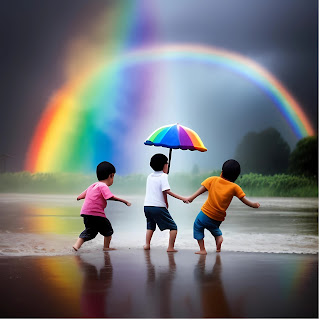|
Artificial intelligence (AI) has made incredible advancements in recent years, especially in image generation. Powerful new algorithms and models like DALL-E 2, Stable Diffusion, and Midjourney allow users to create highly realistic and creative images simply by providing a text prompt. In this post, we'll explore the capabilities of AI image generation, best practices for generating quality images, and the implications of this emerging technology.
How AI Generates Images
Most AI image generators use "diffusion," which progressively adds noise to an image over multiple iterations until it forms a coherent result. Models are trained on millions of image-text pairings to learn the relationships between words and visual concepts. When you provide a text prompt, the algorithm searches its training data to generate an image that matches the description.
Some key advantages of diffusion over older generative models:
· More photorealistic and higher-resolution images
· Ability to iteratively improve images by providing additional prompts
· Retains both high-level structure and fine details
Capabilities and Limitations
Today's AI image generators are capable of producing remarkably detailed and creative images. Here are some key capabilities:
Realistic Representations
The algorithms can generate realistic faces, landscapes, objects, and more based on text prompts. The results often look indistinguishable from real photos.
Artistic Renderings
AI can produce original digital artworks spanning various styles from oil paintings to anime illustrations based on prompts.
Conceptual Ideas
It can take conceptual ideas and render them into photorealistic images. For example, prompts like "astronaut riding a horse on Mars." Also, watch the video link below for more digital image examples (https://youtu.be/aQnxm3TAHS0?si=B88li29EHMS6Ra1k)
However, AI image generation does have some limitations:
- May include biases, distortions, or artifacts.
- Limited ability for nuanced, abstract concepts.
- Legal and ethical issues around copyright and appropriation.
- Currently better for realism than abstraction.
Best Practices
Follow these tips to get the most out of AI image generators:
Provide Clear, Concise Prompts
The more details you provide the better - describe colors, lighting, composition, style, mood, etc. Ambiguous prompts produce ambiguous results.
Try Different Phrasings
Rephrase prompts with synonyms and specify visual details to iterate on ideas.
Use Prompt Conditioning
Add instructions like "extremely detailed", "8k resolution", and "Unreal Engine" to improve quality.
Cite Your Sources
If you upload or reference copyright images, make sure to credit the creator.
Understand the Technology's Limitations
You may need to retry a few times and tweak prompts to get your intended result.
Implications and Ethics
Like any transformative technology, AI image generation raises many ethical questions:
Copyright: Proper attribution must be given to any copyrighted works.
Bias: Models contain unavoidable biases from training data that can lead to stereotypical or problematic imagery.
Misuse potential: Images could potentially be used to spread misinformation or inappropriate content.
Economic impact: Some artists and creatives are concerned about the technology's effect on digital art.
More analysis, governance, and oversight will be needed as use cases develop. Overall, responsible use that respects IP, avoids harmful stereotypes and considers social impacts is encouraged.
The Future of AI Art
While AI image generation is still in its early stages, rapid progress in the field suggests many exciting possibilities ahead:
- Photorealistic video generation
- 3D model and environment creation
- Augmented reality and VR applications
- Personalized avatar and character design
- Enhanced creativity tools for professionals
- Customizable game assets and world-building
As with any transformative technology, challenges will be overcome, but the creative potential is enormous. While AI will not replace human artists and designers, it will complement and enhance human creativity in exciting new ways.
Conclusion
AI image generation represents an incredible leap in computer vision and creativity. While there are valid concerns and limitations to consider, the technology enables entirely new forms of visual expression and problem-solving. As models continue to improve, this technology will likely become an integral part of graphic design, media production, gaming, conceptualization, and other visual arts. However responsible, ethical use that respects IP, avoids bias, and considers societal impacts is crucial as adoption expands.
Try It Out Yourself!
Ready to create your own AI art? Here are some popular image generators to test out:
DALL-E 2 - Advanced generative AI from OpenAI. Waitlist access.
Midjourney - Imaginative bot on Discord. Limited free tiers.
Stable Diffusion - Create images from text descriptions. Some free tiers are available.
Let us know what you think of AI image generation in the comments below!
Frequently Asked Questions
How quickly can AI create images?
Most AI image generators can produce initial results in under a minute, often just 10-30 seconds. Multiple variations can be generated rapidly by tweaking the text prompt.
Are the images copyright-free?
No, images generated by AI are subject to copyright law like any other creative work. Proper attribution should be provided.
Can the images be used commercially?
It depends. Most AI platforms have specific license guidelines on how their models can be used commercially. Some offer paid tiers for commercial use.
How good is the image quality?
State-of-the-art models like DALL-E 2 can produce 1024x1024 or higher resolution images with impressive levels of photorealism and creativity. But quality varies across platforms.
What's the difference between DALL-E, Stable Diffusion, and Midjourney?
Each platform uses unique models and training data. DALL-E focuses on photorealism. Stable Diffusion offers artist control. Midjourney produces abstract, imaginative art. Quality and capabilities vary.
Source: Canva
| .png)
